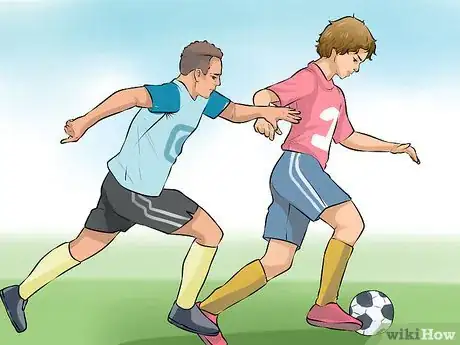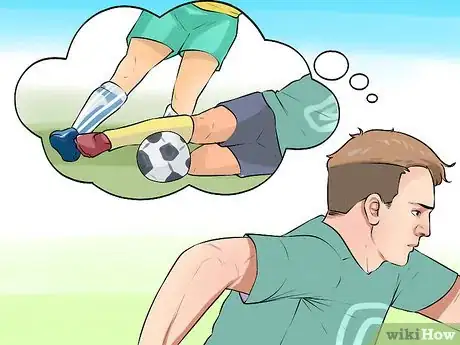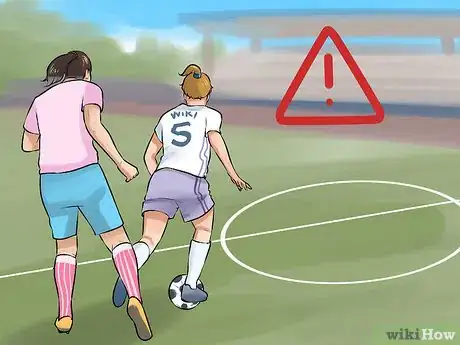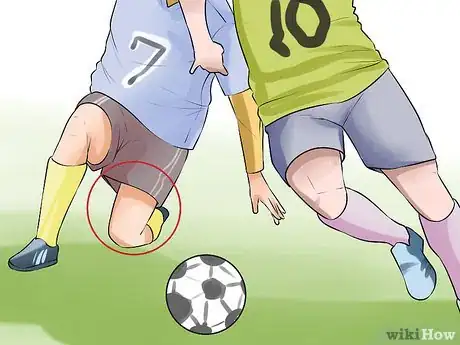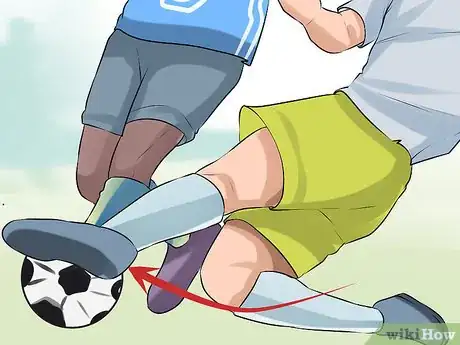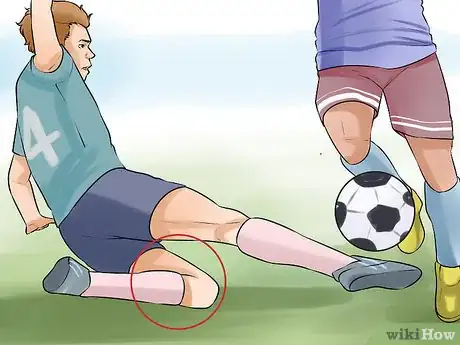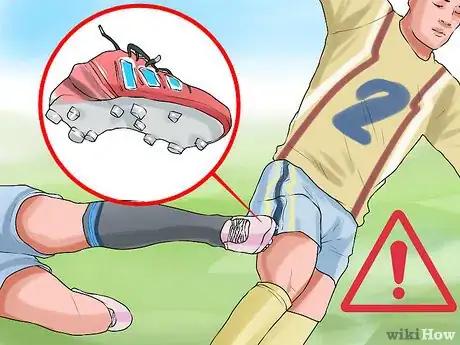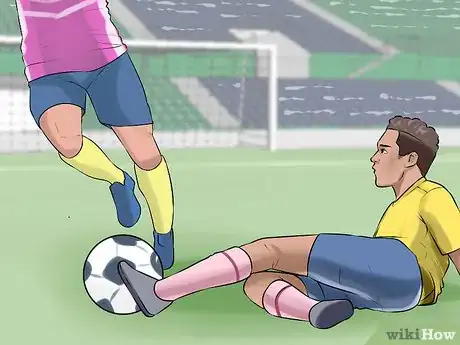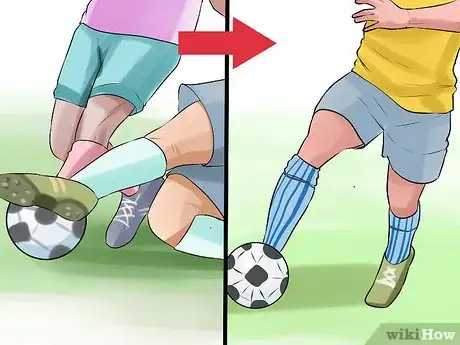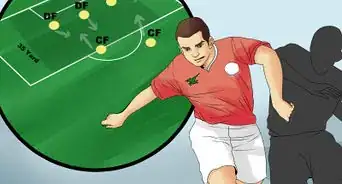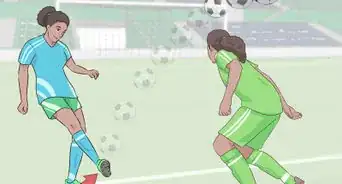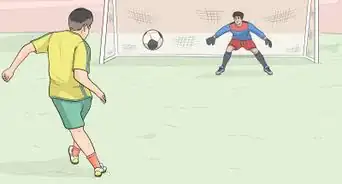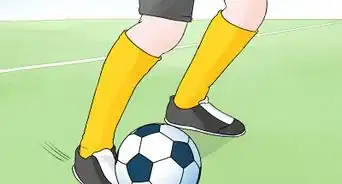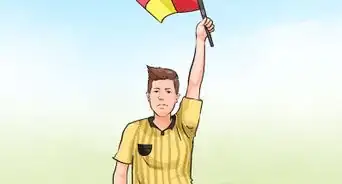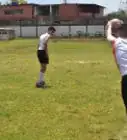This article was co-authored by Bernat Franquesa. Bernat Franquesa is the Co-Founder and Head of Methodology at APFC (Albert Puig Football Concepts), a youth development program for players and coaches with headquarters in San Diego, California. APFC provides soccer training for youth and educational content and consulting services for coaches, academies, and clubs. At APFC, Bernat is responsible for co-developing and applying technical guidelines for player development programs. He has been coaching soccer in Catalunya and the US since he was 15 years old.
There are 8 references cited in this article, which can be found at the bottom of the page.
This article has been viewed 114,923 times.
There are a number of tackling options in soccer and the slide tackle is considered the riskiest and flashiest, but it can make for an incredible play if performed properly. The basic form includes sliding on your bent leg while taking the ball with your extended leg.
Steps
Approaching
-
1Run alongside your opponent. The most common time to slide tackle is when you are chasing the ball beside your opponent. You can tackle from the front, or coming toward them as well, but never tackle from behind. Slide tackling from behind is illegal and will earn you a red card.[1]
- If you aren’t keeping pace with them and they start to get ahead of you, don’t slide tackle as you’ll be more likely to get carded for tackling behind. Your opponent should be at most about 1 step ahead of you, as you’ll make up that ground with the slide.
- Slide tackling is only recommended as a last resort if your opponent is getting too close to scoring. If you can get the ball away by other means, you should do that instead of a slide tackle.
-
2Keep your eyes on the ball. This is standard advice for most sports. What makes it useful when performing a slide tackle is that if your opponent happens to guess at your intentions, they may try to pull the ball away from you. If you keep your eyes fixed on the ball, you have a better chance of stealing it away during your tackle.[2]
- You’ll want to perform the slide when the ball is either out away from your opponent, or at least being kicked with the leg closest to you. This will give you the best chance of stealing it.
Advertisement -
3Determine what you want to do with the ball.[3] A slide tackle is useful for knocking the ball away from your opponent, especially out of bounds if you want to slow the play down. You can also use it as a steal to gain possession of the ball. What you want to do with the ball will slightly affect the technique you use for the tackle.[4]
- If you simply want to kick the ball away from your opponent, you don’t need to worry as much about your exact foot placement. If you want to hook the ball toward you and keep possession of it, then you need to have good control of how your foot connects with the ball.
-
4Take account of where you are in the field. A slide tackle is often good to knock the ball out of bounds, so the middle of the field may not be the best spot. It is also a good idea to have help nearby to assist after you knock the ball clear.
- You need to know if you are close to the out of bounds or the middle of the field and if you have teammates nearby or if you are alone. Watch the ball but have the rest of the area in your side view so you know what you’re dealing with.
- If you intend to steal the ball away but you are too close to the out of bounds line you may lose the ball unintentionally, so be extra careful in this case.
Tackling
-
1Bend the leg that is nearest to the other player. Each leg has a purpose during the slide tackle, and the leg closest to the other player is there to help you get up quickly after the tackle. As you begin your slide, bend the near leg and tuck it under your butt.[5]
- Your foot should go slightly out to the side of your body so that you don’t land directly on it.
- Immediately after the tackle, your bent leg will help you pop back up onto your feet.
-
2Slide with the leg that’s further from your opponent extended. If it works to position yourself in this way, you should use your dominant leg to connect with the ball because you’ll have more control. You should do this at the same time that you bend your other leg.[6]
- An effective slide tackle needs to be one fluid motion that includes bending one leg, extending the other, sliding onto the ground and connecting with the ball.
-
3Land on the hip of the extended leg. You don’t want to slide so that your butt is parallel to the ground, rather you want to be angled onto the hip of the extended leg. This positioning gives you better control over your foot.[7]
-
4Keep your cleats down. One of the main dangers of the slide tackle is hitting your opponent with the cleats of your shoe. Never make a slide with your cleats up. This will earn you a penalty, and could possibly injure the other player.[8]
- Pointing the toes of the foot that will make contact with the ball is one of the best ways to avoid having your cleats up. It’s also the best form for hooking the ball, so there are 2 benefits.
-
5Make contact with the ball. The only way for a slide tackle to be legal is if your foot hits the ball before it hits the player.[9] Make contact either at the center of the ball or slightly on the top half. If you hit the ball too low it is likely to roll over your foot and cause you to lose control of it.
- Best case scenario is that you make contact with your laces as this gives you more control. Never make contact with the bottom of your foot.
- This is the point when timing is most important because you can easily miss the ball and make contact with the other player, which is not what you want to do.
- To knock the ball away, simply make good contact with your laces and your opponent should lose control. You can try to knock it out of bounds, or you can try to knock the ball toward one of your teammates
-
6Swing your extended leg outward. If you are knocking the ball away, you don’t necessarily need to do this. To hook the ball, once your laces connect, pull your foot back toward yourself to pop the ball away from your opponent. Make a slight swinging motion and pop your foot at the same time.
- This is the trickiest part of the slide tackle as you may end up knocking it away even if you wanted to keep it.
- If you successfully pull the ball away, it’s important to get up and start dribbling it immediately before your opponent has time to react and steal it back.
Following Up
-
1Get up quickly. Part of the riskiness of a slide tackle is that it leaves you off your feet and out of the play for at least a few seconds. It is important to get up as quickly as possible and either start dribbling the ball, if you kept it, or get back in position to help your teammates.[10]
- Use your bent leg to push back up onto your feet quickly. It’s also helpful to use the arm on the same side of your body that kicked the ball to push yourself up.
-
2Dribble up the field after stealing the ball. If the goal of your slide tackle is to steal the ball from your opponent, then it is important to keep possession as soon as you steal it. After you hop up, start dribbling away from the person you stole the ball from.
- Quickly scan the field to find your opponents. Try to get a pass off to a teammate if you aren’t in good field position.
-
3Locate the ball and chase it down if necessary. If your slide tackle knocked the ball away from your opponent, it may have gone out of bounds, to another player, or it may be sitting in the open. If it went out of bounds or another player recovered it, there isn’t much you can do. If the ball is in the open, get to it as fast as possible.
- A slide tackle that launches the ball across the field may not be the most helpful tactic, but if it does happen, you still have time to recover.
- If you locate the ball, make a quick decision about what you need to do to get back into the action.
Expert Q&A
Did you know you can get expert answers for this article?
Unlock expert answers by supporting wikiHow
-
QuestionWill I get a foul if I slide tackle during a game?
 Bernat FranquesaBernat Franquesa is the Co-Founder and Head of Methodology at APFC (Albert Puig Football Concepts), a youth development program for players and coaches with headquarters in San Diego, California. APFC provides soccer training for youth and educational content and consulting services for coaches, academies, and clubs. At APFC, Bernat is responsible for co-developing and applying technical guidelines for player development programs. He has been coaching soccer in Catalunya and the US since he was 15 years old.
Bernat FranquesaBernat Franquesa is the Co-Founder and Head of Methodology at APFC (Albert Puig Football Concepts), a youth development program for players and coaches with headquarters in San Diego, California. APFC provides soccer training for youth and educational content and consulting services for coaches, academies, and clubs. At APFC, Bernat is responsible for co-developing and applying technical guidelines for player development programs. He has been coaching soccer in Catalunya and the US since he was 15 years old.
Licensed Soccer Coach & Head of Methodology at APFC
-
QuestionWhen coming up on an opponent as a keeper, what's the best way to slide towards the ball without needing to kick with your feet?
 Misty BensonMisty Benson is a Soccer Coach and Academic Specialist in Plano, Texas. She has been the head coach of high school soccer teams since 2003 and the Coordinator for US Soccer National Teams since 2013. She has a Master’s Degree in Educational Administration from Texas A&M-Commerce.
Misty BensonMisty Benson is a Soccer Coach and Academic Specialist in Plano, Texas. She has been the head coach of high school soccer teams since 2003 and the Coordinator for US Soccer National Teams since 2013. She has a Master’s Degree in Educational Administration from Texas A&M-Commerce.
Soccer Coach
-
QuestionIs there a way to avoid hurting myself and my opponent?
 Community AnswerYes, keep your eyes open and on the ball and tackle the ball, rather than your opponent's feet.
Community AnswerYes, keep your eyes open and on the ball and tackle the ball, rather than your opponent's feet.
Warnings
- Slide tackles are risky for your own safety, your opponent’s safety, and as a defensive technique because if you fail you lose track of your opponent. Talk to your coaches to make sure whether or not they want you to use slide tackles.⧼thumbs_response⧽
- The most important safety element is to slide into the ball and not into your opponent’s feet or legs, as this can cause serious injury to both you and the other player.⧼thumbs_response⧽
References
- ↑ Bernat Franquesa. Licensed Soccer Coach & Head of Methodology at APFC. Expert Interview. 3 March 2020.
- ↑ https://www.myactivesg.com/sports/football/training-methods/football-for-beginners/when-to-use-a-slide-tackle-in-football
- ↑ Bernat Franquesa. Licensed Soccer Coach & Head of Methodology at APFC. Expert Interview. 3 March 2020.
- ↑ https://www.thesoccerstore.co.uk/blog/football-training/getting-the-basics-of-football-right-passing-tackling-shooting-and-heading/
- ↑ http://www.humankinetics.com/excerpts/excerpts/soccer-has-three-basic-tackles
- ↑ https://www.soccercoachweekly.net/soccer-drills-and-skills/tackling/how-to-coach-the-slide-tackle/
- ↑ https://howtheyplay.com/team-sports/Soccer-tackling-techniques-Types-of-tackles
- ↑ https://www.football-bible.com/soccer-info/soccer-foul-rules-misconduct-explained.html
- ↑ Bernat Franquesa. Licensed Soccer Coach & Head of Methodology at APFC. Expert Interview. 3 March 2020.
About This Article
If you want to perform an effective slide tackle, approach your opponent by running alongside them. As you approach, bend the leg nearest the opponent, then extend your other leg to slide and connect with the ball. To perform the tackle safely, always keep your eyes on the ball, never tackle from behind, and make sure your cleats are facing down. After the tackle, pop up quickly and find the ball so you can take possession or return to defense. Keep reading to learn more about the slide tackle, like how to land on your hip.
